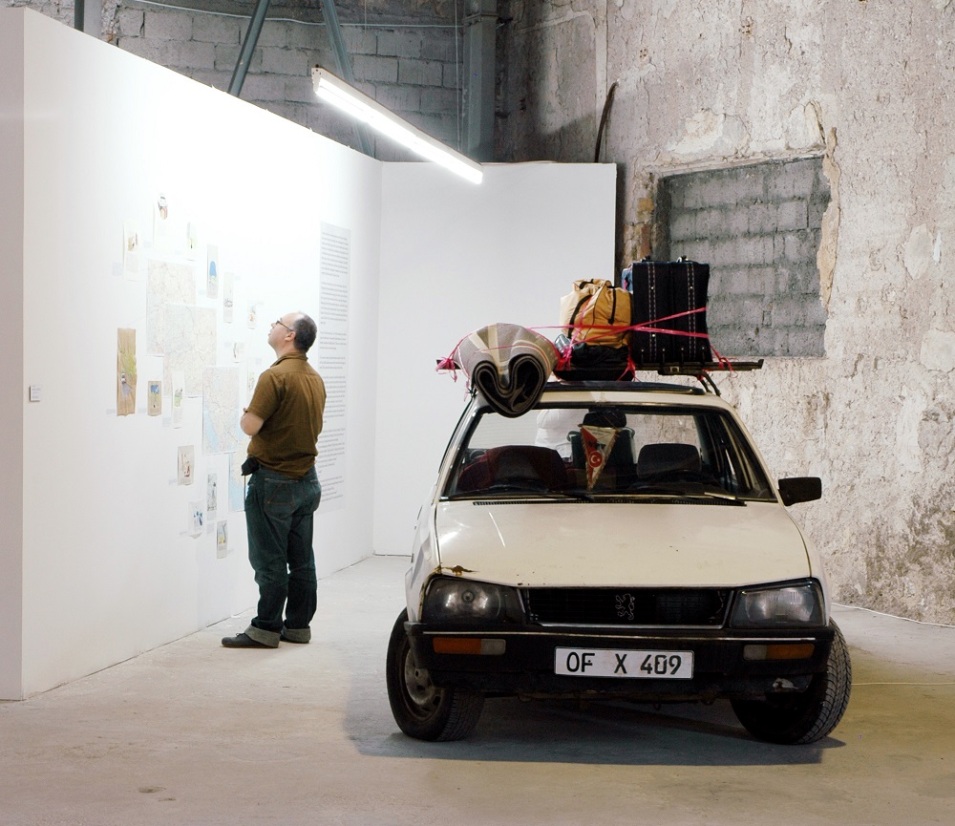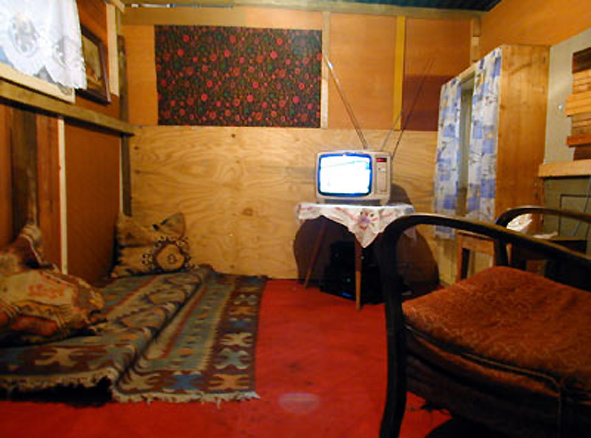Behind the Wheel
Cetinje Biennale, 2003
The Öztürks are very precise about their travels and the distances they have covered. In their Behind the Wheel (2004) is an installation of 16 images on various sorts of paper, 4 maps, a text piece, completed with a sound-track and a used automobile. All images are gouaches of moments in a journey, each in the same casually charming style, between a travel brochure and a children’s book . Beneath all of them are hand-written texts that do and don’t make some sense of them. A white car waiting to loaded with four gouache suitcases, three in each of the primary colours and one in a dirty brown, clearly displays its registration number, and the writing of this number shares a hand with the narrative script beneath. This in turn refers both to the first image, ‘Die koffer waren gepackt’, and perhaps also to the one on brown paper immediately below, ‘die strassen noch nicht so voll…’; and perhaps to the almost empty road in the painting to its right, below which in turn the script tells us that the Croatian landscape is beautiful and looks like Austria. But here, back in the lower left, the luggage seems to reappear as a little abstract motif on the roof rack of a quite different vehicle, a large white people-carrier that forms a formal composition with a passing red car. And again, to the right, the white car is back in the fourth gouache with two figures sitting on a bench where it is parked, captioned by a paragraph that tells nothing of the image. There is no ‘Turkish flag fluttering in the wind…’
This sheet belongs in a larger installation, and as we attend to it we discover a logic of dissociation, a migration of words and colours between the parts of an illusion. This is the same time both a dispersal and a gathering of the ways of making marks, inscribing word as if it were only image, of installing or of hearing that have all become the substance of our being-contemporary in the practices of art. There is no one story in the end, just things to say and things to see, that go back to a journey which is both a fiction and not a fiction: for the images and their makers have come here before us, but what they have brought are incommensurable fragments from making art and living life as they have made and lived. In their journey maps as well then, as in their tiny stories of moments in a street, a mother or a grandparent, they assemble the morsels of real space of travel, of an incident literally remembered, but cluster them together only to embed them in the making of the work, so that the emotional or visual charge of each element is inseparable from artists’ materials and abstracted vision. They constellate a thinking, a seeing and a feeling of inside and outside, a map of boundary and edge, of here and there, that always returns us to the mark, the fabrication, the work and the body of the viewer; and so to their own uncanny presence in space, on paper, in light, in smell and sound.
Anny and Sibel Öztürk discover these multiple figurations of spaces and of times perhaps only for us to lose our track of them as we find our way into and through their work. At some moment of our perception of the stories that they tell, unforeseeable a sound, a text, a texture, a breeze, a written phrase distracts and its beauty, its sensuality or its enigma blur any literal response. In this being-not quitepresent to us, the artists offer us something like this: not just the haunting of an Other, but a renewal of our own haunting otherness to ourselves. And, as Julia Kristeva has argued, might not this be enough of a universal for us, as we are? or for Europe now; a gift of self-estrangement and of recognition.
Adrian Rifkin










